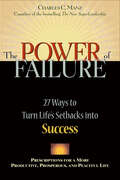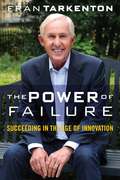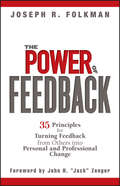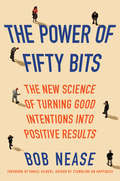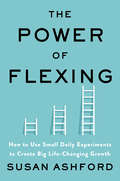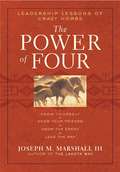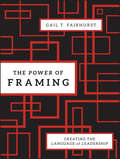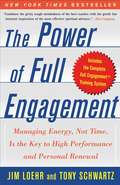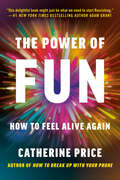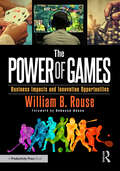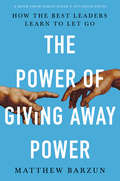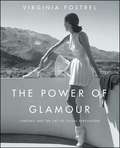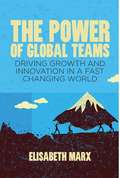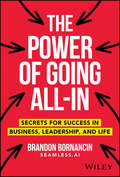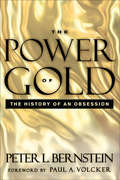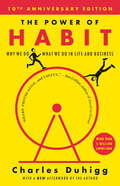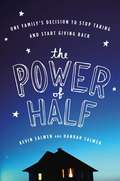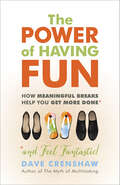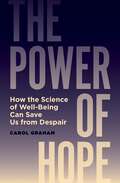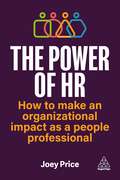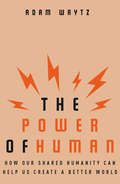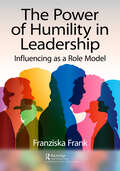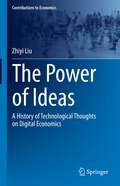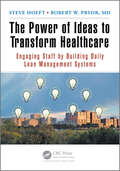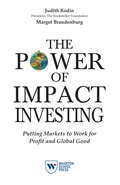- Table View
- List View
The Power of Failure: 27 Ways to Turn Life's Setbacks into Success
by Charles C. ManzThe acclaimed author and leadership expert offers inspiration and practical advice on finding the opportunities within life&’s obstacles. &“Failure&” is one of the most dreaded words in the English language. The very idea of failing causes many of us to simply pack up and retreat without even trying. Yet it is through seeming failure that most of life's greatest successes are achieved. In The Power of Failure, Charles Manz provides simple yet profound ways to turn what appear to be failures into the essential steppingstones of achievement. The Power of Failure offers both inspiration and advice on how failure can provide us with the foundation for long-term success. Along with real-life stories and examples, it contains practical prescriptions for meeting some of life's most common setbacks. These lessons help us take advantage of the opportunities hidden within life&’s daily challenges, and show us how we can fail to succeed.
The Power of Failure: Succeeding in the Age of Innovation
by Fran TarkentonFailure is your key to success. So says Hall of Fame quarterback and hugely successful serial entrepreneur Fran Tarkenton. Don’t get him wrong--there’s no one more competitive or keener on winning than Fran. But in his inspiring and insightful new book, The Power of Failure, Tarkenton illustrates with hard, real-life examples why the most successful entrepreneurs are those with the courage, the resilience, the intelligence, and the competitive spirit to fail often, fail faster, and fail better--to achieve ultimate success. Candid, concise, quotable, and realistic, Fran Tarkenton is the best possible guide to finding success through the power of failure.
The Power of Feedback
by Folkman Joseph R. Zenger John H.Praise for The Power of Feedback "Some books are worthy of being recommended simply because of their subject matter. . . . There is no greater force to improve the quality of human relationships or improve the way organizations function than to multiply the amount and improve the quality of feedback. " "Other books are worthy of being recommended . . . when an author takes an otherwise abstract, obtuse subject and turns it into an actionable, practical set of things to do. Joe Folkman has accomplished that task . . . helping individuals and organizations to develop feedback-rich environments . . . [and] change through the use of a variety of surveys and feed?-back instruments. He has made this topic highly engaging and accessible. " "So, here you have the best of everything--an important topic; a talented, entertaining, and highly qualified author; content that is practical; and a text written in an easily comprehended manner. Enjoy. " --From the Foreword by John H. "Jack" Zenger "Joe Folkman has years of experience and miles of wisdom from coaching and training high-performance organizations. He speaks truth: change is hard. But feedback can be very powerful if the receiver makes the commitment to lasting change. Folkman has scored a home run with The Power of Feedback. " --Maria Nalywayko Senior Vice President, Human Resources, Fremont Investment & Loan "Most of us are clueless when it comes to providing feedback. But now, thanks to Joe Folkman's The Power of Feedback, we have a road map for turning the feedback we receive into lasting and profound change. " --Jeffrey Gill Director of Organization Capability, The Coca-Cola Company
The Power of Fifty Bits
by Bob NeaseEven with the very best of intentions, people often fail to make wise choices for themselves--whether for their health, their finances, or their business decisions. Yet it doesn't have to be that way--thanks to the science behind fifty bits design, a set of principles that helps close the gap between intentions and actual behaviors.Of the ten million bits of information our brains process each second, only fifty bits are devoted to conscious thought. This means that humans are wired for inattention and inertia, so we often choose without thinking and act against our own interests. Understanding this is the key to any behavior change, from increasing charitable donations to reducing unintended pregnancies.As the former chief scientist of Express Scripts, a Fortune 25 health care company, Bob Nease is an expert on applying behavioral sciences to the health care industry. He realized that providing financial incentives and tools--an approach that assumes patients will act rationally--was not having the outcome that he expected. Instead, he had to reengineer patients' environments in order for their natural inclinations to lead them to the best decisions. In a nod to the brain's fundamental cognitive limitation, he called this approach "fifty bits design," and now he applies his knowledge to the wider world, offering important, practical solutions that marketers, human resources professionals, teachers, and even parents can use to improve the behavior of others around them and get the positive results they want.Nease offers a set of powerful and effective strategies for change:* Require Choice: compel people to deliberately choose among options* Lock In Good Intentions: allow people to make decisions today about choices they will face in the future* Let It Ride: set the default to the desired option and let people opt out if they wish* Get in the Flow: home in on where people's attention is likely to go naturally* Reframe the Choices: set the framework people use to consider options and choices* Piggyback It: connect the desired choice or behavior with something people already like or are engaged in* Simplify...Wisely: make the right choices frictionless and easy; make the wrong choices more difficultThe Power of Fifty Bits is the first how-to guide that provides step-by-step instructions for helping customers, employees, co-workers, and clients get the results they truly want.Advance Praise for The Power of Fifty Bits"In many ways, this book is yet another one of Bob's cleverly engineered systems, expertly designed to hook you with an enigmatic title, hold you with delightful stories and deep ideas, and ultimately leave you better than you were before--wiser about people in general, and about yourself in particular."--from the foreword by Daniel Gilbert"Want to learn how to design approaches that spur others to achieve their goals--and that do the same for you and your own goals? With clarity, eloquence, and humor, The Power of Fifty Bits shows you how."--Robert B. Cialdini, author of Influence"If you want to understand how the environment you live in can be reshaped so that your intuitions, fears, hopes, and dreams can best be managed and aligned with your best intentions, I recommend you read this fun, challenging, and useful book."--Arthur Caplan, professor of bioethics, NYU Langone Medical Center"The Power of Fifty Bits shows you how to produce outcomes that have both high financial effectiveness and high acceptance by employees."--Bob Ihrie, SVP of Compensation and Benefits, Lowe's Companies, Inc."The Power of Fifty Bits is a great resource for creating state-of-the-art programs to promote well-being. Combining evidence for effective behavior change with practical advice, this book will transform your thinking and put you on a path to a much better life."--Helen Darling, strategic advisor, National Business Group on Health"Bob Nease is a pioneer of implementing social science in business and healthcare, and we are lucky to have him share his expertise."--Dan Ariely, author of Predictably Irrational"This book proves ...
The Power of Flexing: How to Use Small Daily Experiments to Create Big Life-Changing Growth
by Susan J. AshfordA leadership and learning expert shows you how to change your behavior, develop soft skills, and achieve personal and professional growth through a series of small experiments she calls “Flexing.” A personnel shift at your organization puts you into a leadership role you don't feel prepared for. Your boss tells you that you seem aloof and unapproachable in client meetings. You need to win the support of the members of a local community group for a project you feel passionate about.Addressing these diverse issues depends on improving your soft skills—such as time management, team building, communication and listening, creative thinking, and problem-solving. But this isn’t as easy as it may seem.Sue Ashford, the chair of the Management and Organizations group at the Ross School of Business, has the solution. In this timely book, she introduces Flexing—a technique individuals, teams, and entire organizations can use to learn, grow, and develop their skills and knowledge with every new project, work assignment, and problem. Flexing empowers you to embrace any challenge and adapt to any change, yielding practical, valuable takeaways that ensure growth.Flexing helps you move ahead when you’re confronted with a new challenge, or simply want to develop a vital skill. It’s a journey that begins with setting a flex goal—stating explicitly what you want to learn and how you want to grow. Once that flex goal is set, you then begin to run experiments, solicit feedback from peers or colleagues, and monitor and tweak your progress on the way to achieving your goal. Flexing can be tailored to each person, allowing you to reflect on your own experiences and incorporate the lessons you learn in the next project you tackle. It’s a growth mindset that will help you become the best version of yourself.Flexing also works with teams and organizations. Ashford teaches small groups and large how to implement flexing to ensure their members are ready for new challenges. With more people moving to remote working full-time and developing new ways of collaborating in teams, this warm and practical guide will help every professional and any organization on the journey to greater effectiveness.
The Power of Four: Leadership Lessons of Crazy Horse
by Joseph M. MarshallIn 1876, the warrior Crazy Horse led a hundred riders in a spectacularly courageous charge against Custer's last stand. What can his example teach us about true leadership today? The best-selling author of The Lakota Way retells the great chief's story to reveal the four principles that made Crazy Horse a dynamic and compassionate leader, not only in battle but in life-lessons that all of us can use, whether we lead or follow.
The Power of Framing
by Fairhurst Gail T.Praise for The Power of Framing "The primary work of leadership involves managing meaning through framing. Fairhurst shows that the way leaders use language to frame people, situations, and events has important consequences for the way individuals make sense of the world and their actions. The Power of Framing is an accessible and inspirational read for leaders who want to shape their organizations in ethically responsible ways. "-J. Kevin Barge, professor, Texas A&M University "An ideal book for MBA students and business professionals who are interested in specific tools for constructing leadership in their professional worlds. By focusing on the language toolbox of leadership, the book empowers anyone to construct leadership through talk and interaction. " -Jolanta Aritz, associate professor, Center for Management Communication, USC Marshall School of Business "Building on her earlier acclaimed work, and written in a highly accessible style, Fairhurst's thoughtful study provides us with a practical and highly relevant analysis of the power of framing language from a leadership perspective. This is a must-have book. " -David Grant, professor of organizational studies, University of Sydney "Communication is the most important element of leadership, and framing of the subject and situation is one of the most powerful tools available to leaders. Gail Fairhurst has created the handbook to help leaders do this right. A must-read for anyone in a leadership capacity. " -Rich Kiley, venture capitalist, and retired Procter & Gamble marketing and HR executive "To be an effective global manager, there is nothing more critical than understanding how to frame an issue so that you are effectively communicating and motivating in a culturally sensitive manner. This book will tune you into these issues and show you how to make certain your communication is properly interpreted by your audience. " -Olga Jacob, general sales manager (Belgium, Netherlands, and Luxembourg), American Airlines
The Power of Full Engagement: Managing Energy, Not Time, is the Key to High Performance and Personal Renewal
by Jim Loehr Tony Schwartz&“Combines the gritty toughmindedness of the best coaches with the gentle-but-insistent inspiration of the most effective spiritual advisers&” (Fast Company). This groundbreaking New York Times bestseller has helped hundreds of thousands of people at work and at home balance stress and recovery and sustain high performance despite crushing workloads and 24/7 demands on their time. We live in digital time. Our pace is rushed, rapid-fire, and relentless. Facing crushing workloads, we try to cram as much as possible into every day. We're wired up, but we're melting down. Time management is no longer a viable solution. As bestselling authors Jim Loehr and Tony Schwartz demonstrate in this groundbreaking book, managing energy, not time, is the key to enduring high performance as well as to health, happiness, and life balance. The Power of Full Engagement is a highly practical, scientifically based approach to managing your energy more skillfully both on and off the job by laying out the key training principles and provides a powerful, step-by-step program that will help you to: * Mobilize four key sources of energy * Balance energy expenditure with intermittent energy renewal * Expand capacity in the same systematic way that elite athletes do * Create highly specific, positive energy management rituals to make lasting changes Above all, this book provides a life-changing road map to becoming more fully engaged on and off the job, meaning physically energized, emotionally connected, mentally focused, and spiritually aligned.
The Power of Fun: How to Feel Alive Again
by Catherine PriceIf you&’re not having fun, you&’re not fully living. The author of How to Break Up with Your Phone makes the case that, far from being frivolous, fun is actually critical to our well-being—and shows us how to have more of it.&“This delightful book might just be what we need to start flourishing.&”—#1 New York Times bestselling author Adam Grant Journalist and screen/life balance expert Catherine Price argues persuasively that our always-on, tech-addicted lifestyles have led us to obsess over intangible concepts such as happiness while obscuring the fact that real happiness lies in the everyday experience of fun. We often think of fun as indulgent, even immature and selfish. We claim to not have time for it, even as we find hours a day for what Price calls Fake Fun—bingeing on television, doomscrolling the news, or posting photos to social media, all in hopes of filling some of the emptiness we feel inside.In this follow-up to her hit book, How to Break Up with Your Phone, Price makes the case that True Fun—which she defines as the magical confluence of playfulness, connection, and flow—will give us the fulfillment we so desperately seek. If you use True Fun as your compass, you will be happier and healthier. You will be more productive, less resentful, and less stressed. You will have more energy. You will find community and a sense of purpose. You will stop languishing and start flourishing. And best of all? You&’ll enjoy the process.Weaving together scientific research with personal experience, Price reveals the surprising mental, physical, and cognitive benefits of fun, and offers a practical, personalized plan for how we can achieve better screen/life balance and attract more True Fun into our daily lives—without feeling overwhelmed. Groundbreaking, eye-opening, and packed with useful advice, The Power of Fun won&’t just change the way you think about fun. It will bring you back to life.
The Power of Games: Business Impacts and Innovation Opportunities
by William B RouseGames have long played a central role in society – actually a central role in the animal kingdom. Their play provides primary behavioral mechanisms that enable animals to learn and socialize. Indeed, "play" is a core animal activity. The principal focus of this book is on how games foster human playing, learning, and competing, including how we can design games to do this better. The author provides a wealth of real-world examples of how he created games for clients in the domains of education, energy, healthcare, national security, and transportation. He has focused on training and aiding for strategic thinking, product planning, technology development, and business operations. The technologies underlying these games became increasingly sophisticated. This has taken on greater significance as the gaming industry has grown and prospered. Gaming revenues now dwarf film and theater. New games released gain millions of sales within a few days of release. What makes games so appealing? What is the psychology of gaming? Does it vary for card games, board games, simulation games, and online games? What makes a game successful over years? What about sports games? What sociological roles do they play in our society? Why do they claim such energy and devotion? Why are sports stars able to earn enormous contracts? What is the business of these games? Why is it expected to be increasingly lucrative? What strategies might succeed or fail? Who might be the losers and winners? This book addresses all of these questions as well as an overarching question for society – Can online games fundamentally enhance the education of employees and students? The author is convinced they can. This requires, however, that games be designed to achieve these ends. This book is intended to contribute to understanding how to create and evaluate such games. Essentially, games enable employees and managers to play, learn, compete, and achieve in terms of knowledge and skills gained, competencies attained, customers attracted, and economic outcomes. This book explains, illustrates, and motivates investments in these pursuits to these ends.
The Power of Giving Away Power: How the Best Leaders Learn to Let Go
by Matthew Barzun&“This book is a breakthrough. It&’s beautifully written, perfectly timed and heralds a new way forward. I&’m buying a dozen copies to share with friends and colleagues.&” -Seth Godin, Founder of altMBA and author of The Practice If you let go of hierarchy, chaos will reign...or so many leaders believe. But when leaders find the courage to distribute rather than hoard power, creativity multiplies, trust deepens, and inclusivity expands... and a new kind of order emerges.A few rare leaders have learned to embrace a new organizational shape and mindset: Constellations. Organizations designed as constellations are dynamic and flexible networks of distinct yet interwoven individuals. Each member of the team feels like a singular star and is also connected to others to form something greater. That is how Visa reimagined how we pay for things, how Wikipedia beat the richest company in the world and how Barack Obama and his grassroots team revolutionized political campaigning. These leaders did what most leaders dread – they gave away power. Barzun brilliantly layers lessons across history and industries with his own experiences as an internet entrepreneur, political organizer, and US ambassador to the United Kingdom and Sweden. The Power of Giving Away Power shows how the Constellation mindset shines in some of the most impactful organizations and innovations the world has ever known. And it encourages us all to recognize, as Barzun writes, "the power we can create by seeing the power in others" — and making the leap to lead. Together.
The Power of Glamour: Longing and the Art of Visual Persuasion
by Virginia PostrelIn provocative detail with more than one hundred illustrations, critically acclaimed author Virginia Postrel separates glamour from glitz, revealing what qualities make a person, an object, a setting, or an experience glamorous.What is it that creates that pleasurable pang of desire—the feeling of “if only”? If only I could wear those clothes, belong to that group, drive that car, live in that house, be (or be with) that person? Postrel identifies the three essential elements in all forms of glamour and explains how they work to create a distinctive sensation of projection and yearning. The Power of Glamour is the very first book to explain what glamour really is—not just style or a personal quality but a phenomenon that reveals our inner lives and shapes our decisions, large and small. By embodying the promise of a different and better self in different and better circumstances, glamour stokes ambition and nurtures hope, even as it fosters sometimes-dangerous illusions. From vacation brochures to military recruiting ads, from the Chrysler Building to the iPad, from political utopias to action heroines, Postrel argues that glamour is a seductive cultural force. Its magic stretches beyond the stereotypical spheres of fashion or film, influencing our decisions about what to buy, where to live, which careers to pursue, where to invest, and how to vote. The result is myth shattering: a revelatory theory that explains how glamour became a powerful form of nonverbal persuasion, one that taps into our most secret dreams and deepest yearnings to influence our everyday choices.
The Power of Global Teams
by Elisabeth MarxThis highly practical book explains how executive teams in global companies can work together to successfully drive change, enable fast growth or restructure the business. It demonstrates a clear correlation between team development and business results and even deals with special issues for teams in the not-for-profit sector and emerging markets.
The Power of Going All-In: Secrets for Success in Business, Leadership, and Life
by Brandon BornancinDiscover a proven framework for leadership you can apply to your own unique environment In The Power of Going All In, serial entrepreneur and sales leader Brandon Bornancin delivers a first-person account of what it takes to build, lead, and manage a world-class company. The author draws on his many years of experience launching and managing successful companies to present effective strategies for inspiring your people to do more, be more, and achieve more. You’ll discover a customizable framework you can apply to your own environment to create your own unique path to leadership greatness, at school, at work, and anywhere else you’re responsible for the performance of those who follow you. You’ll find: Tried-and-tested methods for unlocking the potential of the people you lead Effective alternatives to counter-productive leadership “strategies,” like micromanagement Reasons why leadership isn’t about the letters behind your name or fancy titles on your office door A practical and effective toolkit for entrepreneurs, managers, executives, board members, founders, sales professionals, and other leaders looking for ways to harness the full potential of the people they lead, The Power of Going All In is also perfect for those looking for a leadership methodology that’s been proven to work in the real world.
The Power of Gold: The History of an Obsession
by Peter L. Bernstein"The need for realism in reform of its monetary system is what makes Bernstein’s story of the Power of Gold so timely. It is a compelling reminder that maintaining a fixed price for gold and fixed exchange rates were difficult even in a simpler financial environment….Peter Bernstein was reluctant to project the story of gold into the future. But to me his message was clear. Yes, gold will be with us, valued not only for its intrinsic qualities but as a last refuge and store of value in turbulent times. But its days as money, as a means of payment and a fixed unit of account are gone." —From the New Foreword by Paul Volcker This bestselling book reveals a record of human nature in the ubiquity of gold with a new foreword by Paul Volcker In this exciting book, the late Peter L. Bernstein tells the story of history's most coveted, celebrated, and inglorious asset: gold. From the ancient fascinations of Moses and Midas through the modern convulsions caused by the gold standard and its aftermath, gold has led many of its most eager and proud possessors to a bad end. And while the same cycle of obsession and desperation may reverberate in today's fast-moving, electronically-driven markets, the role of gold in shaping human history is the striking feature of this tumultuous tale. Such is the power of gold. Whether it is Egyptian pharaohs with depraved tastes, the luxury-mad survivors of the Black Death, the Chinese inventor of paper money, the pirates on the Spanish Main, or the hardnosed believers in the international gold standard, gold has been the supreme possession. It has been an icon for greed and an emblem of rectitude, as well as a vehicle for vanity and a badge of power that has shaped the destiny of humanity through the ages. Discusses the beginnings of gold as something with magical, religious, and artistic qualities and follows its trail as we progress to the invention of coinage, the transformation of gold into money, and the gold standard Other bestselling books by the late Peter Bernstein: Against the Gods, Capital Ideas, and Capital Ideas Evolving Contemplates gold from the diverse perspectives of monarchs and moneyers, potentates and politicians, men of legendary wealth and others of more plebeian beginnings Far more than a tale of romantic myths, daring explorations, and the history of money and power struggles, The Power of Gold suggests that the true significance of this infamous element may lie in the timeless passions it continues to evoke, and what this reveals about ourselves.
The Power of Habit: Why We Do What We Do in Life and Business (Playaway Adult Nonfiction Ser.)
by Charles DuhiggA young woman walks into a laboratory. Over the past two years, she has transformed almost every aspect of her life. She has quit smoking, run a marathon, and been promoted at work. The patterns inside her brain, neurologists discover, have fundamentally changed. Marketers at Procter & Gamble study videos of people making their beds. They are desperately trying to figure out how to sell a new product called Febreze, on track to be one of the biggest flops in company history. Suddenly, one of them detects a nearly imperceptible pattern--and with a slight shift in advertising, Febreze goes on to earn a billion dollars a year. An untested CEO takes over one of the largest companies in America. His first order of business is attacking a single pattern among his employees--how they approach worker safety--and soon the firm, Alcoa, becomes the top performer in the Dow Jones. What do all these people have in common? They achieved success by focusing on the patterns that shape every aspect of our lives. They succeeded by transforming habits. In The Power of Habit, award-winning New York Times business reporter Charles Duhigg takes us to the thrilling edge of scientific discoveries that explain why habits exist and how they can be changed. With penetrating intelligence and an ability to distill vast amounts of information into engrossing narratives, Duhigg brings to life a whole new understanding of human nature and its potential for transformation. Along the way we learn why some people and companies struggle to change, despite years of trying, while others seem to remake themselves overnight. We visit laboratories where neuroscientists explore how habits work and where, exactly, they reside in our brains. We discover how the right habits were crucial to the success of Olympic swimmer Michael Phelps, Starbucks CEO Howard Schultz, and civil-rights hero Martin Luther King, Jr. We go inside Procter & Gamble, Target superstores, Rick Warren's Saddleback Church, NFL locker rooms, and the nation's largest hospitals and see how implementing so-called keystone habits can earn billions and mean the difference between failure and success, life and death. At its core, The Power of Habit contains an exhilarating argument: The key to exercising regularly, losing weight, raising exceptional children, becoming more productive, building revolutionary companies and social movements, and achieving success is understanding how habits work. Habits aren't destiny. As Charles Duhigg shows, by harnessing this new science, we can transform our businesses, our communities, and our lives.From the Hardcover edition.
The Power of Half: One Family's Decision to Stop Taking and Start Giving Back
by Kevin Salwen Hannah SalwenIt all started when 15-year old Hannah Salwen, idealistic, but troubled by a growing sense of injustice in the world, had a eureka moment when a homeless man in her neighborhood was juxtaposed against a glistening Mercedes coupe "You know, Dad," she said, pointing, "If that man had a less nice car, that man could have a meal." This glaring disparity let the Salwen family of four, caught up like so many other Americans in this age of consumption and waste, to follow Hannah's urge to stop talking and start doing. And so they embarked on an incredible journey together, deciding to sell their Atlanta mansion, downsize to a house half its size, and give half of their profits to a worthy charity Each week they met over dinner to discuss their plan. At first it was an outlandish scheme. "What, are you crazy? No way!" Then it was a challenge. "We are TOTALLY doing this." It would transport them across the globe and well out of their comfort zone. In the end they found a needy village in Ghana where their commitment of funds and their unwavering follow through would change the lives of hundreds, for good. It would also alter irrevocably the lives of four normal Americans who learned together that half could be so much more. With deft prose, an unassuming tone, and an endearing sense of humor, The Power of Half chronicles this remarkable, unlikely journey, this reimagining of the American dream, one family at a time. It also offers readers a very accessible road map to employ the power of half to their own lives, no matter one's means or resources. In that way, it shows readers, how to connect their families through a unifying purpose, an antidote to the splintering of American families in this era of iPods, video-gaming, and other solo activities.
The Power of Having Fun: How Meaningful Breaks Help You Get More Done *and Feel Fantastic!
by Dave Crenshaw&“A powerful system for making fun a vital part of your business strategy&” from the author of The Myth of Multitasking (Asher Raphael, Co-CEO and partner, Power Home Remodeling). Fun is the key to success! If you want to be successful, having fun is not an option. It&’s a necessity. By making fun a top priority—taking meaningful, enjoyable breaks each day, week, month, and year—you&’ll not only be happier but be more productive, too! Using scientific evidence, real-world case studies, and a healthy dose of wit, bestselling author Dave Crenshaw shows that a regular respite is like a little oasis in your workday. It refreshes and reinvigorates, recharges your batteries—helping you accomplish more with less effort! The Power of Having Fun coaches you through the five-step system thousands of leaders have utilized to boost productivity and propel their careers—all while feeling fantastic! Let Dave Crenshaw lower your stress, raise your results, and restore recess to your routine. &“The simple wisdom in Dave&’s book might just change your life.&” —Seth Godin, New York Times-bestselling author of This Is Marketing &“Let&’s face it, the nine-to-five workday is a thing of the past. Dave really gets that the companies that will ultimately succeed are those that embrace the flexible workday and empower their employees.&” —Brian Halligan, cofounder and CEO, HubSpot &“The principles Dave teaches in this book have helped me be not only a more productive leader but a more grounded human being. Dave&’s influence in my life and career has been invaluable.&” —Catherine Hoke, founder and CEO, Defy Ventures
The Power of Hope: How the Science of Well-Being Can Save Us from Despair
by Carol GrahamWhy hope matters as a metric of economic and social well-beingIn a society marked by extreme inequality of income and opportunity, why should economists care about how people feel? The truth is that feelings of well-being are critical metrics that predict future life outcomes. In this timely and innovative account, economist Carol Graham argues for the importance of hope—little studied in economics at present—as an independent dimension of well-being. Given America’s current mental health crisis, thrown into stark relief by COVID, hope may be the most important measure of well-being, and researchers are tracking trends in hope as a key factor in understanding the rising numbers of “deaths of despair” and premature mortality.Graham, an authority on the study of well-being, points to empirical evidence demonstrating that hope can improve people’s life outcomes and that despair can destroy them. These findings, she argues, merit deeper exploration. Graham discusses the potential of novel well-being metrics as tracking indicators of despair, reports on new surveys of hope among low-income adolescents, and considers the implications of the results for the futures of these young adults.Graham asks how and why the wealthiest country in the world has such despair. What are we missing? She argues that public policy problems—from joblessness and labor force dropout to the lack of affordable health care and inadequate public education—can’t be solved without hope. Drawing on research in well-being and other disciplines, Graham describes strategies for restoring hope in populations where it has been lost. The need to address despair, and to restore hope, is critical to America’s future.
The Power of HR: How to Make an Organizational Impact as a People Professional
by Joey PriceHow can I influence the business and drive meaningful change as an HR professional? How can I improve organizational performance and showcase my value? How can I prove that HR professionals are key to company success? The Power of HR is a practical guide that answers all these questions and equips HR professionals with everything they need to make an impact on the organization. It outlines the key aspects of the HR role, examines how they add value to the business and explains how practitioners can demonstrate this value to the organization. It includes coverage of the importance of attracting and hiring the people with the skills the business needs to meet its objectives, effective onboarding of these staff as well as guidance on how to communicate the value of this to the business. This practical book also covers HR's essential role in company culture and why people professionals are integral to fostering diversity, equity, inclusion and belonging at work and the corresponding effect this has on company performance. This book also has a dedicated chapter on using insights from data and analytics in HR activity to provide people professionals with the evidence they need to make an impact and influence business priorities. Full of real-world examples from companies such as Adobe, Google, LexisNexis, Jumpstart HR and NPR as well as interviews from HR professionals and industry experts including Dave Ulrich, Lars Schmidt and Adonica Black, this is ideal reading for all HR professionals wanting to demonstrate their value to the organization, drive change and influence business decision making.
The Power of Human: How Our Shared Humanity Can Help Us Create A Better World
by Adam WaytzAn urgent yet hopeful analysis of the surge in dehumanization, and how we can reverse it. The unprecedented access to other humans that technology provides has ironically freed us from engaging with them. Thanks to social media, we can know a campaigning politician’s platform; an avid traveler’s restaurant recommendations; and the daily emotional fluctuations of our friends without ever even picking up the phone. According to social psychologist Adam Waytz, our increasingly human-free lives come with a serious cost that we’ve already begun to pay: the loss of our humanity. Humans have superpowers. More than any other psychological stimulus, our presence can make experiences feel significant, inspire moral behavior, and encourage action. Recent studies suggest that we even have power over mortality—the survival rate of individuals with stronger social relationships has been found to be twice as high as those with weak relationships. The Power of Human shows us how to rehumanize and harness these unique abilities to improve our lives, beginning with our jobs. The remedy for the dehumanized worker is twofold. Employers, Waytz argues, must instill humanity into work by capitalizing on distinctly human skills, especially sociability and variability. Meanwhile, workers need to put to rest the idea that you are what you do and instead detach their personal identities from their occupations. Waytz offers a similarly science-based method to counter the rising threat that technology poses to our humanity, outlining how we can design human-machine partnerships that optimize the strengths of both parties. Finally, he reveals how, by humanizing intimacy and conflict in unexpected ways, we can strengthen relationships with both our friends and enemies. Essential reading for individuals and institutions alike, The Power of Human explains how we can solve one of our time’s biggest problems by better utilizing the influence we have on one another.
The Power of Humility in Leadership: Influencing as a Role Model
by Franziska FrankTo many people, the words ‘leader’ and ‘humble’ are not natural bedfellows. Yet once they have grasped the definition most employees desire a humble leader, while a majority of managers believe they already are one. What appears deceptively simple is trickier than expected. Narcissism, lack of perception, fixed mindsets, and neuronal default settings are only a few of the stumbling blocks on the path to humility. What exactly is this sought-after humility? Humility consists of four key elements: 1) Seeing one’s own strength and weaknesses and revealing them where needed for the bigger picture; 2) Appreciating others for what they are, do now and can do; 3) Being open and willing to learn; 4) Understanding that we are all only a small part of a larger picture, easily replaceable and favored by luck and circumstance. Therefore, humility has nothing to do with being weak or hiding the light under the bushel. Instead, it is about clarity, taking a step back from one’s ego and thus being able to serve the greater picture. The author’s own research with more than 2,000 managers contributes to the canon of positive effects of humility that have been measured by dozens of researchers during the last decade. Humility benefits employees (ranging from better performance, more innovation, stronger resilience to better client relations, and stronger morals), the organization (ranging from better ambidextrous strategies, a better culture to fewer sunk costs) and the managers themselves (ranging from more seen leadership potential to less stress and better relationships with employees). Dozens of case studies, quotes from more than 150 interviews with top managers, lively storytelling of real-life examples, and solid research with actionable take-aways, plus personal assessments, make this an eminently readable and practical book for managers worldwide.
The Power of Ideas: A History of Technological Thoughts on Digital Economics (Contributions to Economics)
by Zhiyi LiuAs the first academic monograph that a Chinese scholar discusses the histories of thoughts and ideas related to the development of digital economics, this book aims to make research from the perspective of the history of ideas and discuss the ideas influencing the development of digital economics and the evolution of related theories and thoughts with the methodology of interdisciplinary research.The human society is in the stage of major historic transition and enters the digital world with the main goal of developing the artificial world. In this world, the development of digital economics is significantly characterized by the deep interaction between the real and the virtual worlds, while the key triggering this paradigm reform is the evolution of ideas since the modern times. While involving the field of computer, these thoughts are also related to the fields of philosophy, ethics, communication and economics. Therefore, the results of the research on the history of ideas related to digital economics are required to really understand the depth of this discipline. If computationalism is the most important paradigm evolution of natural science, the most important paradigm evolution of social science is interdisciplinary complex science. In the meantime, this book is the most significant in understanding the nature of paradigm evolution related to the development of digital economics from the perspective of complex science and interdisciplinary systematic researches.Digital economics is in the foundation-laying phase, while this book mainly aims to historically narrate the thoughts of this discipline and hopes that readers can understand the influence of ideas in the old era on shaping the disciplines in the new era while exploring this new discipline. The construction of digital economics is a process of evolution. This book will be helpful to understand the underlying logic of the ideas constructed by the thinkers in different fields.
The Power of Ideas to Transform Healthcare: Engaging Staff by Building Daily Lean Management Systems
by Steve Hoeft Robert W. Pryor MDMany companies conduct Lean training and projects, but few have tapped the wealth of ideas in the minds of their staff like Baylor Scott and White Health. This book documents the path Steve Hoeft and Robert Pryor created at Baylor Scott and White Health and shares what worked as well as what didn t illustrating over seven years of successes and fai
The Power of Impact Investing: Putting Markets to Work for Profit and Global Good
by Judith Rodin Margot BrandenburgA new wave of investors is using impact investing to address some of the greatest challenges of our time-from climate change and water scarcity to lack of access to health care, education, and affordable housing-with the intention of also generating a financial return. <P><P>This couldn't happen at a more critical time. While philanthropy continues to be a transformative force for good, global philanthropic funds, even when combined with the development or aid budgets of many national governments, add up to mere billions of dollars. Meanwhile, the cost of solving the world's problems runs into the trillions.In The Power of Impact Investing, Rockefeller Foundation president Judith Rodin and Margot Brandenburg, two of the foremost experts in the field, explain what impact investing is, how it compares to philanthropy and traditional investments, where opportunities are evolving around the world, and how to get started.By sharing moving stories of impact investors and the exciting social enterprises benefiting from these investments, Rodin and Brandenburg offer a compelling resource for anyone interested in better understanding the power of impact investing-including retail investors, high-net-worth individuals, and heads of family offices, foundations, banks, and pension funds-while also offering experienced impact investors an opportunity to deepen their knowledge and benefit from the perspectives of other investors.
